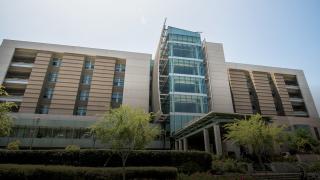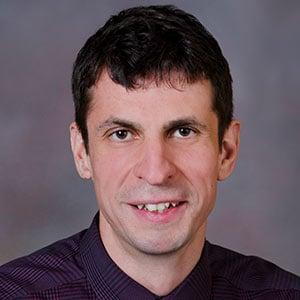Watch Alexey Danilov, M.D., Ph.D., in action during a typical day at City of Hope and you wonder how one individual does so many different things — treating patients, running a research team, overseeing clinical trials and much more — and does them so well.
He is, in many ways, a study in contradictions. Young, tall and lanky with a rich, Russian-accented baritone, this physician/scientist from Yaroslavl (“a quintessential Russian city about five hours north of Moscow,” he said) cuts an imposing, even intimidating figure. He’s a world leader in the study and treatment of chronic lymphocytic leukemia (CLL) and many forms of lymphoma. He’s published dozens of papers and initiated multiple drug trials. He dazzles with his formidable repository of technical knowledge. His work has won him an enviable list of honors and awards.
He also sends colleagues and patients into convulsive laughter with his antics and inside jokes.
Like those traffic tickets posted on his wall, labeled “Victory #1. Victory #2. Victory #3!”
“He got cited for not having a front license plate,” explained Vi Lam, a research assistant in Danilov’s lab. “Each time he wrote a letter [challenging the fine], and each time he got it reduced. He’s very proud of that!”
Sure, he’ll kid around. But ask about his work, and he is super serious. Everything, he says, is patient-centered. His goal as both clinician and scientist has never varied from the day he chose to attend medical school and specialize in hematology.
“I realized how much I could help patients,” he recalled.
Danilov arrived from Oregon Health & Science University (OHSU) in early 2020 and brought his independently funded lab with him, folding it into City of Hope’s Toni Stephenson Lymphoma Center, where he is associate director. He is focused on a particular niche of targeted therapy: identifying cell proteins — some that promote cancer growth, some that inhibit it — learning how they deteriorate, and finding drugs that can affect the process.
“All proteins degrade,” he explained. “By targeting components of that system, you can modify the outcome. We can prolong the life of anti-cancer proteins and shorten the life of the pro-cancer ones.”
It has paid off.
“We’ve identified multiple protein components,” he continued. “We can now target more of them and see more net results. And we’ve discovered that even some already-existing drugs target proteins in ways we hadn’t known before.”
Nothing is theoretical in the Danilov lab. He gears all projects to their ultimate benefit in the real world and he infuses that attitude among his staff.
A Clinician and a Scientist
“He’s a clinician as well as a scientist, and he brings patient issues into the lab,” declared lab staffer Tingting Liu, Ph.D. “He’s always reminding us that our primary drive must be what’s best for the patient.”
Sounds like an ideal fit for the City of Hope universe and its translational “bench-to-bedside” mission. But Danilov takes it a step further, bringing actual results, data and samples from his clinical patients back into the lab to further his research. Call it “bench-to-bedside-to-bench.”
“My work relies on Alexey’s patients,” said Lam, referring to her boss with the relaxed, no-rank informality he insists upon.
“As a clinician, he understands the effect of a drug on a patient, so he focuses on projects that will be helpful in the clinic. Not in five or 10 years, but right away.”
He doesn’t know another way.
“I could never be a researcher of the hypothetical,” he declared, “where you have an idea but can take it only so far. Here, I look at a slide, then I go see a patient. This way you can actually verify what you found in the lab, or find out you were wrong, so you ask a different question. This is where it really gets interesting.”
Danilov says many of his patients eagerly offer to provide samples or participate in trials. Most see his research commitments as a plus in their favor. And far from spreading himself too thin, Danilov takes the time to bond with each patient, to always be accessible, to develop a real friendship.
“He is the best specialist I’ve ever seen,” said Christina Fisher, owner of a real estate company in Boring, Oregon, and Danilov’s patient since 2017. She’d endured years of false steps and misdiagnoses before finding Danilov to treat her CLL. They hit it off immediately.
“He lumbers in,” she recalled. “He looked so young so I figured, he must be intelligent. He had this endearing, compassionate, happy attitude. It was so sweet. And he was so smart, telling me all about his research data. He assured me that my CLL was not a death sentence, that there was major hope for me. I knew he had my back.
“Plus, I liked the accent!”
He enrolled Fisher in a phase 2 trial for obinutuzumab (also called Gazyva), then switched her after 15 months to a just-approved regimen of Venclexta and rituximab.
Every visit provided an opportunity for the two of them to … well … get silly.
“There’s lots of joking. I always try to make him laugh. I’ll jump off the exam table and throw a mock karate chop at him.”
She remembers waiting in that room on the first day of the trial, a nerve-wracking time for anyone.
“I’m there with my whole family. I’m not sure he knew that. So he bursts in and announces in a loud voice, “Let’s do this!”
They’re laughing all the way to a happy ending.
“I’m physically strong, I’m skiing again,” said Fisher. “I’m hopeful for a remission in the next two years. And I couldn’t be in better hands. [Dr. Danilov] shows his heart to his patients. And his unwavering work to find a cure is so impressive.
“He’s going to do great things.”

